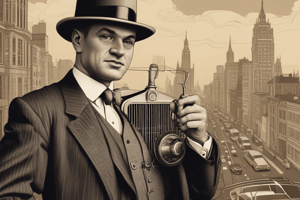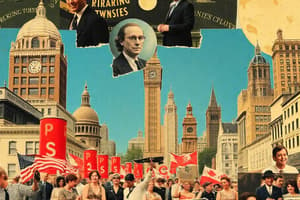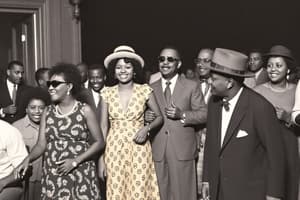Podcast
Questions and Answers
Which of these social changes occurred in the 1920s?
Which of these social changes occurred in the 1920s?
- The creation of new dance crazes (correct)
- A rise in support for Communism
- A decline in the popularity of sports figures
- Increased restrictions on immigration (correct)
The 18th Amendment, also known as Prohibition, was very popular with Americans.
The 18th Amendment, also known as Prohibition, was very popular with Americans.
False (B)
What was a major reason for the lack of public support for Prohibition?
What was a major reason for the lack of public support for Prohibition?
The law was widely disregarded, with many people continuing to drink illegally.
The rebellious young women of the 1920s were known as ________.
The rebellious young women of the 1920s were known as ________.
Match each social phenomenon with its description.
Match each social phenomenon with its description.
Which of the following is NOT true about the social changes of the 1920s?
Which of the following is NOT true about the social changes of the 1920s?
The federal government effectively enforced Prohibition.
The federal government effectively enforced Prohibition.
What kind of music emerged as a uniquely American form with roots in African expression during the 1920s?
What kind of music emerged as a uniquely American form with roots in African expression during the 1920s?
Which of the following events contributed to a sense of disillusionment and nervousness in the American society after World War I?
Which of the following events contributed to a sense of disillusionment and nervousness in the American society after World War I?
The 1920s saw a tightening of social structures and a stricter adherence to traditional morality.
The 1920s saw a tightening of social structures and a stricter adherence to traditional morality.
What was the primary factor contributing to the change in the status of women during the 1920s?
What was the primary factor contributing to the change in the status of women during the 1920s?
The ______ was a period of significant social change, marked by a loosening of traditional morals and a shift in societal expectations.
The ______ was a period of significant social change, marked by a loosening of traditional morals and a shift in societal expectations.
Match the following terms with their descriptions:
Match the following terms with their descriptions:
The rise of the Mafia in American society during the 1920s was directly linked to the legalization of alcohol.
The rise of the Mafia in American society during the 1920s was directly linked to the legalization of alcohol.
Describe the social atmosphere of the 1920s in terms of the relationship between the sexes.
Describe the social atmosphere of the 1920s in terms of the relationship between the sexes.
Which of the following best describes the social impact of the mass-produced automobile in the 1920s?
Which of the following best describes the social impact of the mass-produced automobile in the 1920s?
What technological innovation significantly boosted the American movie industry in the 1920s?
What technological innovation significantly boosted the American movie industry in the 1920s?
The widespread adoption of machinery in the 1920s led to a decrease in the demand for manual laborers.
The widespread adoption of machinery in the 1920s led to a decrease in the demand for manual laborers.
What were some of the societal changes brought about by the rise of household appliances and ready-made clothing in the 1920s?
What were some of the societal changes brought about by the rise of household appliances and ready-made clothing in the 1920s?
The emergence of the [BLANK] in the 1920s marked a significant shift in the dietary habits of Americans.
The emergence of the [BLANK] in the 1920s marked a significant shift in the dietary habits of Americans.
Match the following technological advancements with their impact on society during the 1920s:
Match the following technological advancements with their impact on society during the 1920s:
The stock market crash of 1929 was a direct result of the widespread adoption of new technologies.
The stock market crash of 1929 was a direct result of the widespread adoption of new technologies.
Which of the following social trends of the 1920s contributed to the increased consumption of fruits and vegetables?
Which of the following social trends of the 1920s contributed to the increased consumption of fruits and vegetables?
How did the increasing popularity of automobiles in the 1920s impact American society?
How did the increasing popularity of automobiles in the 1920s impact American society?
Flashcards
The American Dream
The American Dream
The ideal that anyone can achieve success and prosperity through hard work and determination.
Prohibition Act
Prohibition Act
The 18th Amendment (1919) that prohibited the sale and consumption of alcohol in the U.S.
Bootlegging
Bootlegging
The illegal production and sale of liquor during Prohibition.
Speakeasies
Speakeasies
Signup and view all the flashcards
Organized Crime
Organized Crime
Signup and view all the flashcards
Roaring Twenties
Roaring Twenties
Signup and view all the flashcards
Social Change of the 20s
Social Change of the 20s
Signup and view all the flashcards
Disillusionment Post-WWI
Disillusionment Post-WWI
Signup and view all the flashcards
Red Scares
Red Scares
Signup and view all the flashcards
Prohibition
Prohibition
Signup and view all the flashcards
Flappers
Flappers
Signup and view all the flashcards
Harlem Renaissance
Harlem Renaissance
Signup and view all the flashcards
Jazz
Jazz
Signup and view all the flashcards
Consumerism
Consumerism
Signup and view all the flashcards
Art Deco
Art Deco
Signup and view all the flashcards
Real estate boom
Real estate boom
Signup and view all the flashcards
Henry Ford's Model T
Henry Ford's Model T
Signup and view all the flashcards
Technicolor
Technicolor
Signup and view all the flashcards
Charles Lindbergh
Charles Lindbergh
Signup and view all the flashcards
Impact of machinery
Impact of machinery
Signup and view all the flashcards
Albert Einstein's Nobel Prize
Albert Einstein's Nobel Prize
Signup and view all the flashcards
Stock market crash
Stock market crash
Signup and view all the flashcards
Flapper's dietary changes
Flapper's dietary changes
Signup and view all the flashcards
Study Notes
The Roaring Twenties and the American Dream
- The 1920s were a time of transition following World War I, marked by disillusionment, social unrest, and economic changes.
- Americans experienced a spirit of idealism initially, but there were also widespread social tensions including racism, intolerance, and violence.
- Economic booming; America partied, organized crime, Prohibition Act, decline of moral standards.
- Optimism prevailed during the era with faith in progress, technological advancements and business innovation driving the economy. Technological breakthroughs such as electricity and automobiles contributed to a widespread sense of progress.
- However, critics argued the 1920s represented a "decline and degradation," focusing too much on material wealth, and resulting in a loss of spiritual life and purpose.
- The 1920s witnessed a changing social atmosphere, notably in evolving gender roles and relationships. Women gain more independence.
- The era saw the rise of urbanization, an attraction to success, and the rise of cinema as a form of entertainment. Jazz music gained popularity immensely.
- Prohibition, the 18th Amendment, resulted in illegal liquor distribution by bootleggers in speakeasies. Famous gangsters emerged during this era.
- Significant changes also happened within the role of women in the 1920s (e.g. the 19th amendment, increased employment, and personal freedoms).
- The roaring 20s were marked by significant artistic and literary achievements (e.g., the rise of writers like F. Scott Fitzgerald, Ernest Hemingway and others).
- The 1920s saw a flourishing of Art Deco styles that encompassed architecture, arts, clothing, hairstyles, and furnishings.
- The Harlem Renaissance emerged as a rich period of African-American artistic works.
1920s: Economic, Technological & Sociological Context
- The US economy shifted from wartime to peacetime after WWI.
- A temporary economic stall occurred after the war.
- In the 1920s, America became the wealthiest nation.
- An era of consumerism flourished as individuals spent money on better roads, tourism, holiday resorts.
- Technological advancements, such as the Model T automobile assembly line, significantly increased productivity and reshaped industries.
- Radio technology became common in everyday American homes.
- The advent of Technicolor modernized movies and broadened the movie industry.
- The 1920s witnessed significant changes in food production, clothing, and household appliances.
- Machinery improved agricultural productivity, but also reduced the need for manual labor.
- The rise of stock speculation led to an economic boom but also potentially significant risks as the 1929 stock market crash signaled the end of this era.
- Health and hygiene advancements, such as immunizations and medical discoveries.
1920s: Political Context
- Warren G. Harding was elected President in 1920 and his administration was riddled with scandals.
- Harding died in 1921; his vice president Calvin Coolidge assumed the presidency.
- Coolidge successfully cleaned up many of Harding's scandalous activities.
- Later, Herbert Hoover became President in 1928, during the height of the American economic boom. His presidency was largely marked by the nation's economic prosperity until the beginning of the Great Depression.
- There is overall evidence of conservative political policies.
1920s: Social Context
- The Red Scare emerged which was a widespread fear of Communism.
- There was a rise of social and cultural movements such as the Ku Klux Klan and restrictions on immigration.
- Prohibition, despite being unpopular, created an environment of criminal activities and increased the rise of organized crime.
- The role of women in society changed with the emergence of "flappers," marked by an evolution in fashion, social attitudes, and freedoms.
- Social crazes/frenzies in the 1920s include dancing, dance marathons, flagpole sitting, and flying stunts.
- Sports stars such as Babe Ruth became icons in the public eye.
- Significant changes happened in the arts and literature.
F. Scott Fitzgerald
- Born in 1896, in St. Paul, Minnesota; attended Princeton University (1911-1912).
- Met Zelda Sayre in 1918 and marries in 1920.
- Published The Great Gatsby in 1925.
- Was an accomplished author, considered to be a voice of the Jazz Age.
- His personal life was marked by struggles with alcoholism and marital issues; his wife Zelda also experienced mental health struggles.
- His work had significant impact and notoriety; he is considered a prominent figure of the era.
- Died in 1940.
The Great Gatsby
- Published in 1925.
- Set during the summer of 1922.
- The novel explores various themes, including the American Dream, social class, and the spirit of the 1920s.
- The novel features a variety of characters and symbolizes different aspects of the time.
Studying That Suits You
Use AI to generate personalized quizzes and flashcards to suit your learning preferences.
Related Documents
Description
Explore the complexities of the 1920s in America, a decade shaped by social changes, economic prosperity, and cultural shifts. This quiz delves into themes such as the rise of organized crime, the impact of prohibition, and evolving gender roles. Understand how optimism intertwined with criticism during this transformative period.




